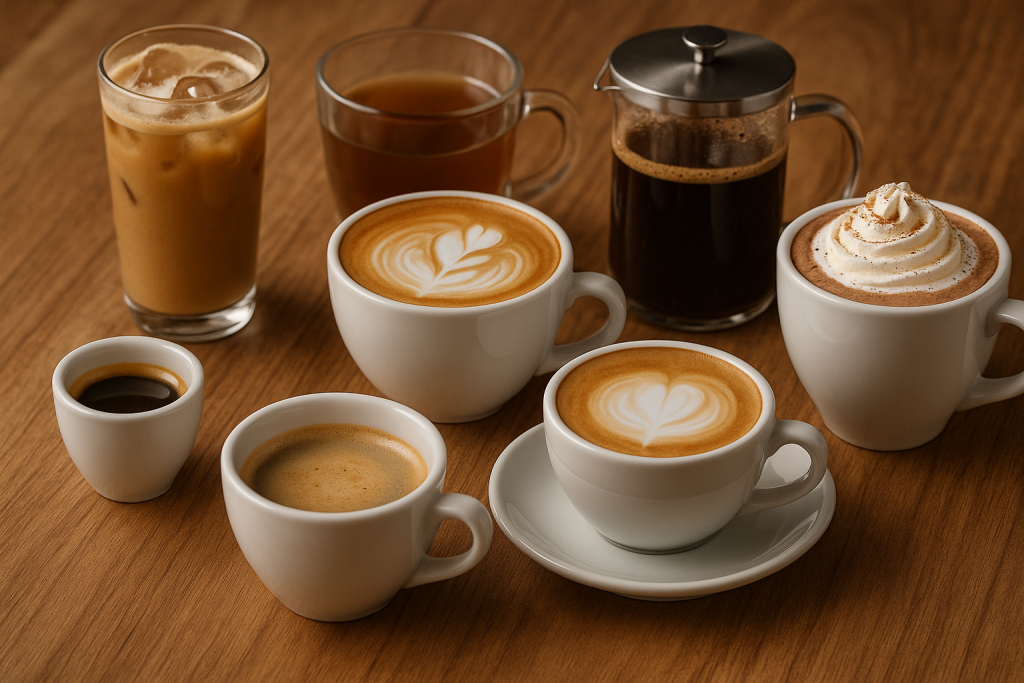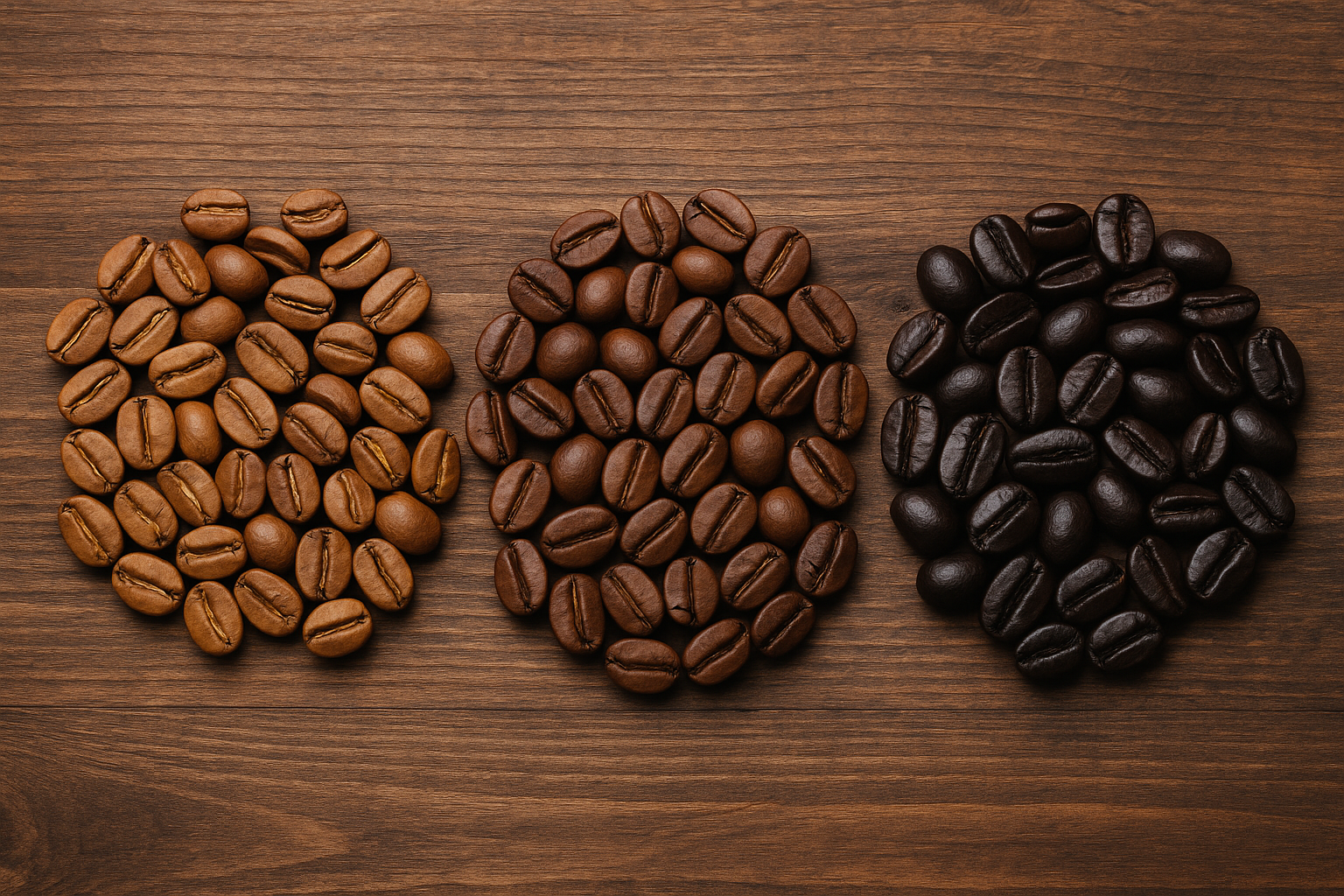Coffee is one of the most popular beverages in the world, with billions of cups consumed every day. Yet, despite its universal appeal, coffee is far from being a one-size-fits-all drink. Walk into any café, and the menu can be overwhelming: espresso, cappuccino, latte, macchiato, cold brew, pour-over, flat white—the list goes on. Each preparation offers a unique flavor, texture, and experience, shaped by history, culture, and brewing technique.
For newcomers, the variety can be confusing, while seasoned coffee lovers may still discover new drinks and brewing methods they haven’t tried before. In this guide, we’ll explore the most popular types of coffee, their origins, and what makes them distinct, helping you navigate the rich and diverse world of coffee with confidence.

Espresso and Espresso-Based Drinks
What Is Espresso?
Espresso is the foundation of many coffee drinks. Originating in Italy, espresso is made by forcing hot water under high pressure through finely ground coffee. The result is a small, concentrated shot with a rich aroma, bold flavor, and a layer of golden crema on top.
Popular Espresso-Based Variations
- Americano: An espresso shot diluted with hot water, creating a lighter, milder taste similar to drip coffee.
- Latte: Espresso combined with steamed milk and a thin layer of foam. Creamy and mild, it’s one of the most popular choices worldwide.
- Cappuccino: A classic balance of equal parts espresso, steamed milk, and milk foam, offering a stronger espresso flavor than a latte.
- Macchiato: Espresso “stained” with a small amount of milk or foam. Stronger and more intense than a latte.
- Flat White: Originating from Australia and New Zealand, it is similar to a latte but with less foam and a stronger coffee-to-milk ratio.
- Mocha: A sweet combination of espresso, steamed milk, and chocolate syrup or cocoa powder, often topped with whipped cream.
Brewed Coffee Methods
Drip Coffee
Perhaps the most common method in North America, drip coffee involves hot water slowly filtering through coffee grounds in a paper filter. It produces a clean, consistent cup and is ideal for large batches.
Pour-Over
A manual brewing method that uses equipment such as a V60 or Chemex. Water is poured slowly and evenly over coffee grounds, allowing precision control over extraction. The result is a clean, bright, and nuanced cup.
French Press
This immersion method steeps coarse coffee grounds in hot water for several minutes before pressing them down with a plunger. It creates a full-bodied, rich coffee with natural oils intact.
Cold Brew
Made by steeping coarsely ground coffee in cold water for 12–24 hours, cold brew is smooth, low in acidity, and often served over ice. It has gained immense popularity in recent years, especially in summer.
Specialty and Regional Coffee Drink
Turkish Coffee
An ancient method still popular in the Middle East and Eastern Europe, Turkish coffee is brewed with extremely fine coffee grounds in a special pot called a cezve. The unfiltered coffee is thick, strong, and often flavored with cardamom.
Greek Coffee
Similar to Turkish coffee, Greek coffee is also unfiltered and served in small cups, often enjoyed slowly in a social setting.
Café au Lait
Popular in France, it is made with equal parts brewed coffee and steamed milk, offering a lighter alternative to a latte.
Vietnamese Coffee
Vietnamese coffee often uses robusta beans and is brewed using a small drip filter called a phin. It’s typically served strong and sweetened with condensed milk, either hot or iced.
Café Cubano
A Cuban-style espresso shot brewed with sugar, creating a sweet, strong, and syrupy coffee often enjoyed in small doses.
Cortado
Originating from Spain, a cortado is equal parts espresso and steamed milk, designed to cut the acidity of espresso without overwhelming it with milk.
Iced Coffee Variations
Iced Coffee
Regular hot coffee brewed and cooled over ice. It is lighter than cold brew and has a sharper acidity since it is brewed hot.
Frappé
Popular in Greece, a frappé is made by shaking instant coffee, water, and sugar into a frothy iced drink. Modern variations often include milk or cream.
Nitro Cold Brew
Cold brew infused with nitrogen gas, giving it a creamy texture and a smooth, beer-like foam head. It is often served straight from a tap.
Coffee Roasts and Their Influence
The type of roast also plays a major role in how coffee tastes, regardless of brewing method.
- Light Roast: Bright, acidic, and highlights the bean’s origin flavors.
- Medium Roast: Balanced flavor, aroma, and acidity.
- Dark Roast: Bold, smoky, and often bitter, with less acidity.
Roast level is a personal preference, but it also determines which brewing method best highlights the flavors. For example, light roasts shine in pour-over methods, while dark roasts are often used in espresso.
Choosing the Right Coffee for You
With so many types of coffee available, the best way to find your favorite is to experiment. Try different brewing methods, explore various roast levels, and sample coffee from multiple origins. Some people prefer the creamy smoothness of a latte, while others love the strong punch of espresso or the refreshing nature of cold brew.
Remember, there is no single “best” coffee—just the one that suits your taste and lifestyle.
Conclusion
Coffee’s diversity is part of what makes it so universally beloved. From simple drip coffee to elaborate espresso-based drinks, every type offers a unique experience shaped by culture, history, and preparation. Understanding these differences not only helps you navigate a café menu but also deepens your appreciation for the craft of coffee-making. Whether you enjoy it hot, iced, sweetened, or black, there’s always a new coffee experience waiting to be discovered.
FAQs (7 Questions)
1. What is the difference between espresso and regular coffee?
Espresso is made by forcing pressurized hot water through finely ground coffee, producing a small, concentrated shot. Regular brewed coffee uses gravity or immersion methods for a larger, lighter cup.
2. Is cold brew the same as iced coffee?
No. Cold brew is steeped in cold water for many hours, resulting in a smoother, less acidic drink. Iced coffee is brewed hot and then cooled over ice.
3. What is the most popular coffee drink in the world?
Globally, espresso and its variations (like cappuccino and latte) dominate café culture, while drip coffee is most common in North America.
4. What type of coffee has the most caffeine?
Per ounce, espresso has the highest caffeine concentration. However, since brewed coffee is served in larger volumes, a full cup of drip coffee typically contains more caffeine overall.
5. What is a flat white compared to a latte?
A flat white has a higher coffee-to-milk ratio and less foam, resulting in a stronger espresso flavor compared to a latte.
6. Can I make specialty drinks like cappuccinos at home?
Yes. With an espresso machine and a milk frother, you can make cappuccinos, lattes, and flat whites at home. Simpler methods like French Press or Aeropress also allow experimentation.
7. What type of coffee is best for beginners?
A latte or cappuccino is often a good starting point, as the milk softens the espresso’s intensity, creating a smooth, approachable drink.

